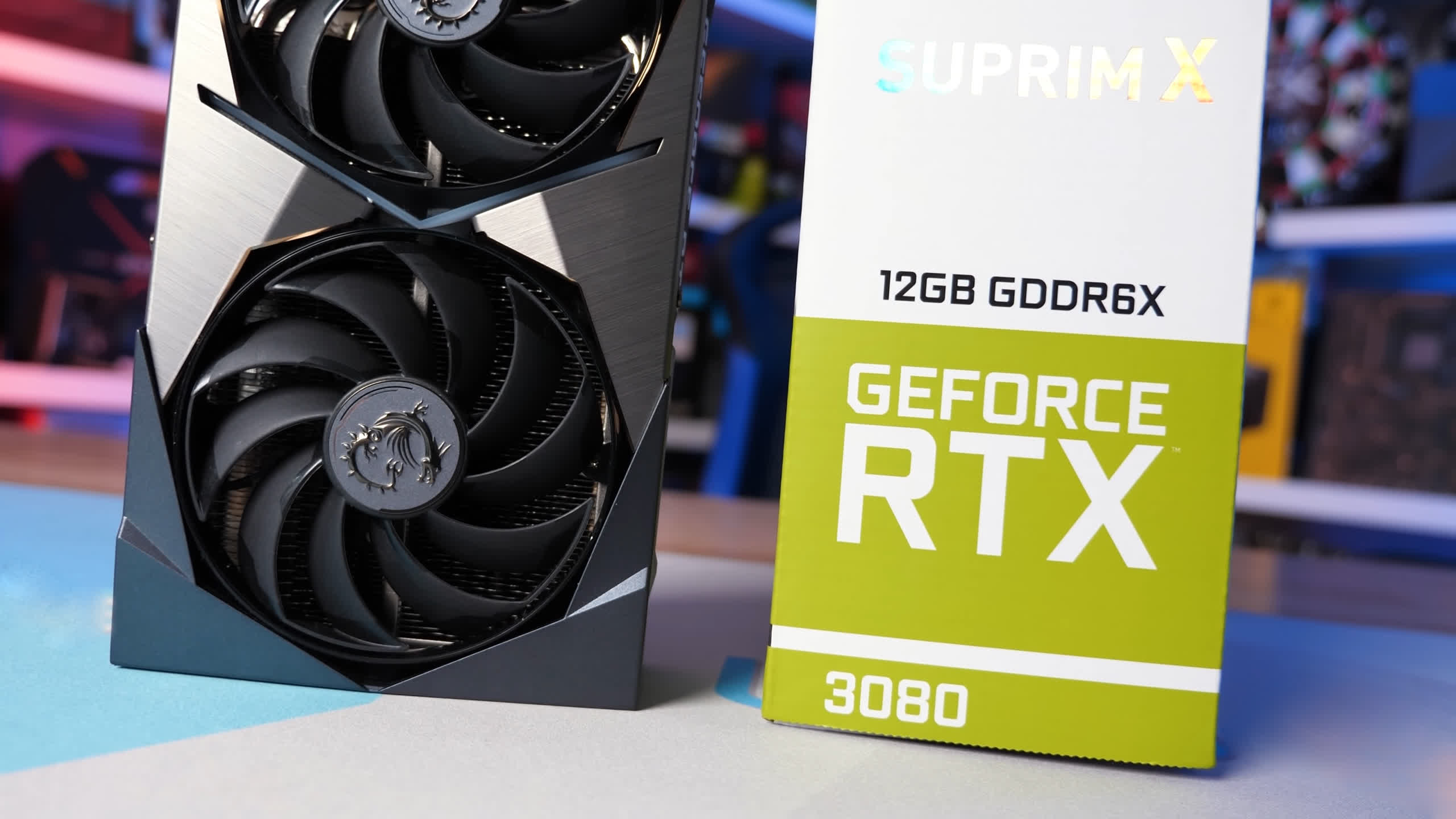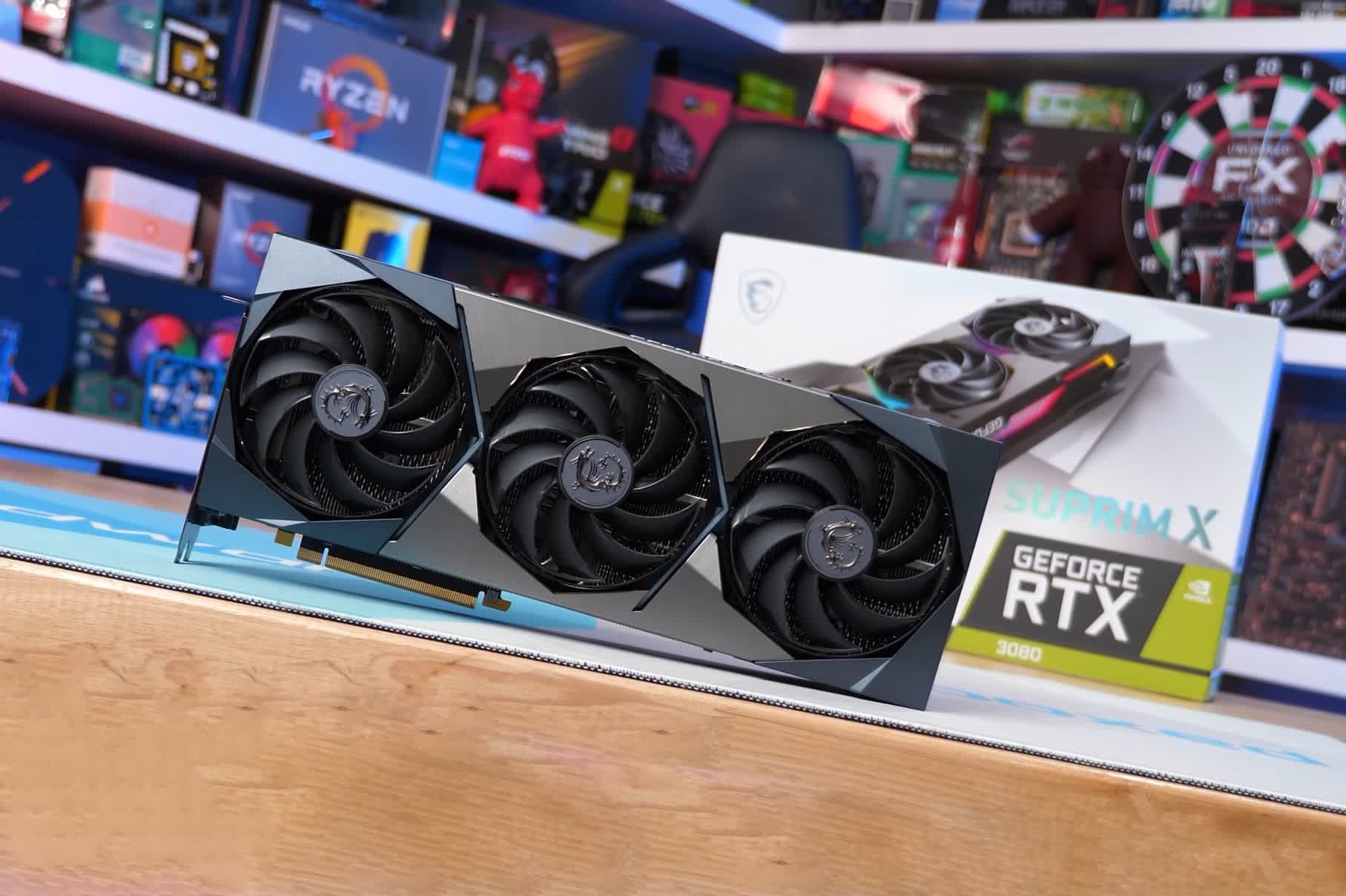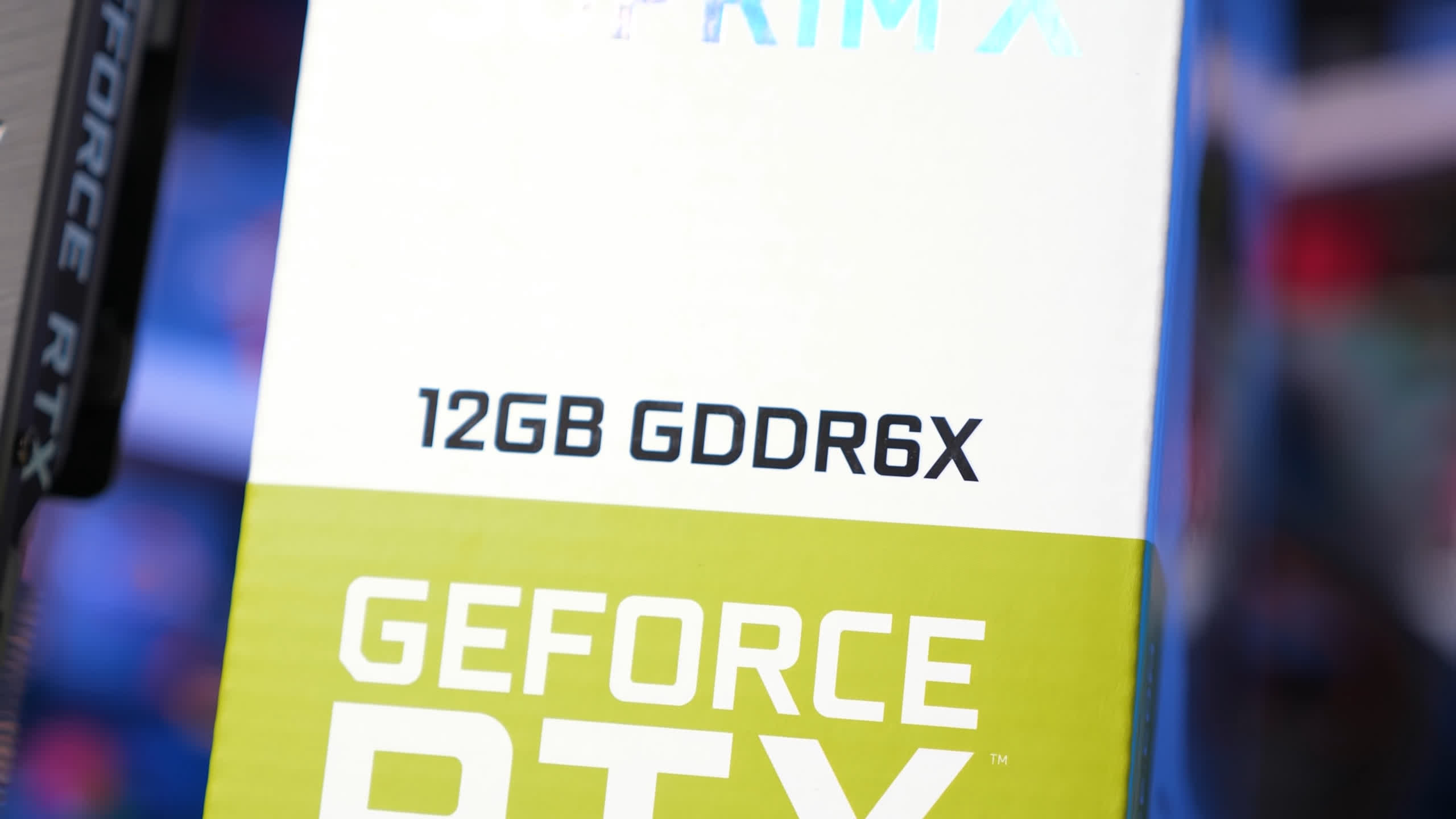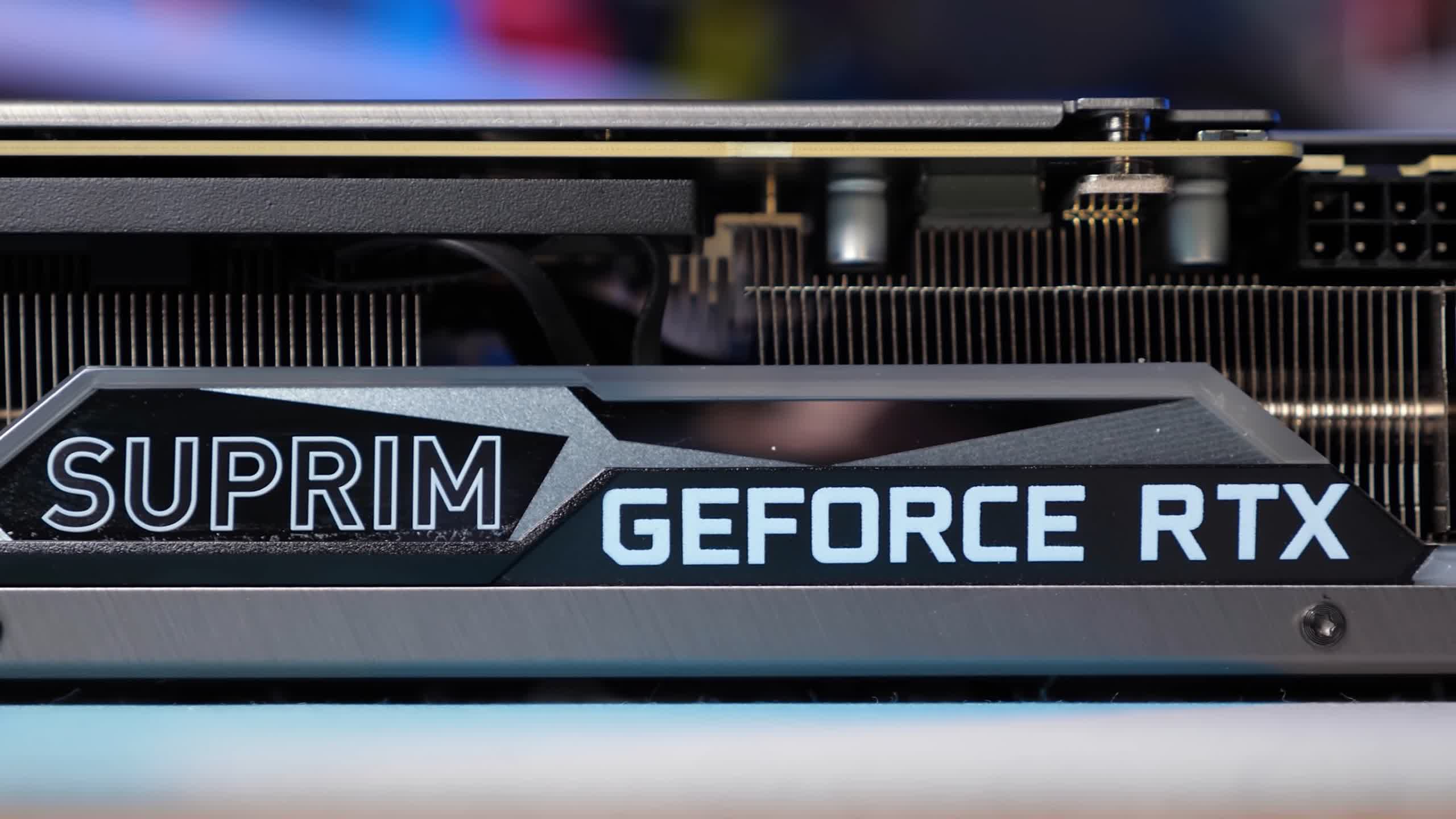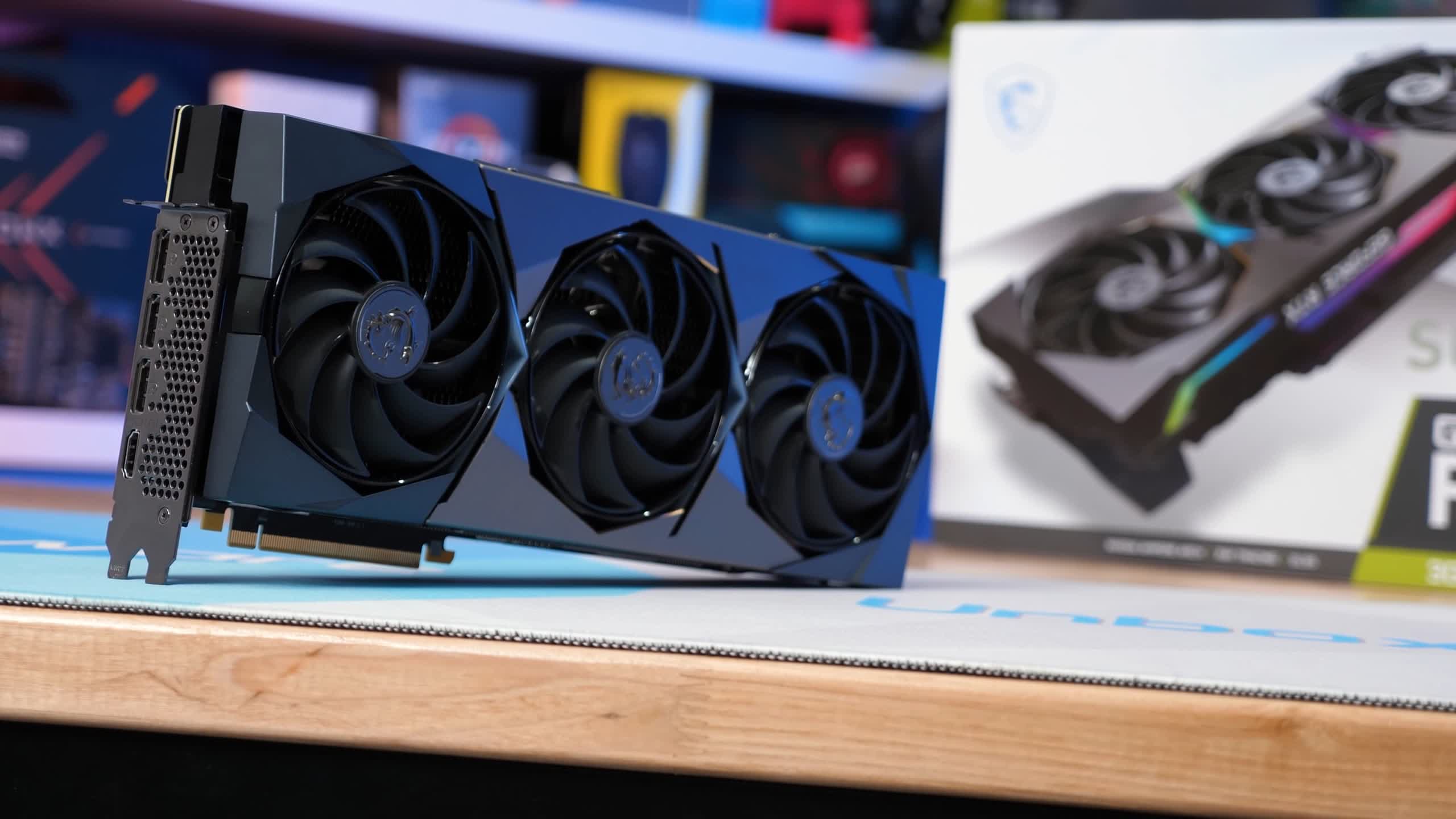Last week Nvidia quietly released a new 12GB variant of the RTX 3080. The card sounds like it's the same as the original 10GB version, but with an extra 2GB of VRAM. And while that's the gist of it, there's a little more to the release. Along with the extra memory, there's a 3% increase in core count and an 8% increase for the ROPs. This sees the 12GB model jump up to a 384-bit wide memory bus for a 20% increase in memory bandwidth, despite the same 19 Gbps GDDR6X memory is being used.
The key change is a 20% increase in memory bandwidth and capacity. With all said and done, the 12GB 3080 will land between the original 3080 and 3080 Ti in terms of performance, and we suspect it will often be closer to the 3080 Ti, so a nice little upgrade there.
But the pressing issue with the 12GB RTX 3080 is the same problem we face with all graphics cards right now: pricing and availability. Given the performance, it's no surprise to find that the 12GB model is positioned between the original 3080 and 3080 Ti.
Depending on where you are, the 12GB 3080 might actually be slightly better value than the 10GB 3080, so you could argue that it's a welcomed upgrade. Personally though, I'd rather Nvidia remained committed to improving availability of the product they released in September 2020, which many people are still waiting for, the original 10GB RTX 3080.
| GeForce RTX 3090 | GeForce RTX 3080 | GeForce RTX 3080 Ti | GeForce RTX 3080 Ti 12GB | |
| Price (MSRP) | $1500 | $700 | $1200 | ??? |
| Release Date | September 2020 | June 2021 | January 2022 | |
| Die Size | 628.4 mm2 | |||
| Core Config | 10496 / 328 / 112 | 8704 / 272 / 96 | 10240 / 320 / 112 | 8960 / 280 / 104 |
| Core/Boost Clock | 1695 MHz | 1710 MHz | 1665 MHz | 1710 MHz |
| Memory Capacity | 24 GB | 10 GB | 12 GB | 12 GB |
| Memory Speed | 19.5 Gbps | 19 Gbps | ||
| Memory Type | GDDR6X | |||
| Memory Bus Bandwidth | 384-bit | 320-bit | 384-bit | 384-bit |
| TDP | 350 watts | 320 watts | 350 watts | 320 watts |
We'll touch more on that towards the end of this review. For now, let's go over the test system specs and then jump into a few benchmark results. For testing we're using our Ryzen 9 5950X GPU test system featuring 32GB of dual rank, dual channel DDR4-3200 CL14 memory. For the GPUs we've tested at the default AMD and Nvidia clock specifications (no factory overclocking) and that means the MSI Suprim X model used to test the 12GB RTX 3080 has been downclocked to that spec.
Another testing note is that while we have decided to start testing CPUs with ResizableBAR enabled, we've yet to do the same for GPUs. The reason is that for CPUs it's a platform feature, so when reviewing a CPU, we're accurately portraying the performance of that product when using Resizable BAR. But for GPUs it's a little different, although ReBAR is technically still a GPU feature, we don't want to assume that everyone has a Ryzen 5000 series processor. Using ReBAR with older Ryzen processors, and of course, Intel CPUs will lead to different results, and in many cases it's not even supported.
For example, the Radeon RX 6800 XT receives a ~20% boost in Assassin's Creed Valhalla with Resizable BAR enabled when using our Ryzen 9 5950X test system, but if you had a Core i9-9900K, the feature isn't supported, which means no gains. This is an issue as the RTX 3080 only receives around a ~5-10% boost with ReBAR enabled in Assassin's Creed Valhalla, and that gives AMD a massive advantage on our Ryzen 5000 test system, an advantage you're unlikely to see on all other platforms. So, until Resizable BAR is supported and works well on a wide range of modern platforms, we're going to limit its use to CPU/platform testing. With that out of the way, let's get into the benchmark data...
Benchmarks
First up let's go over the updated Assassin's Creed Valhalla data. Starting with 1080p, the 3080 12GB, original 3080 and the 3080 Ti all delivered about the same performance, and here we're architecturally bottlenecked with Ampere unable to efficiently feed all the cores at this lower resolution, leading to the 6800 XT showing ~14% more performance.
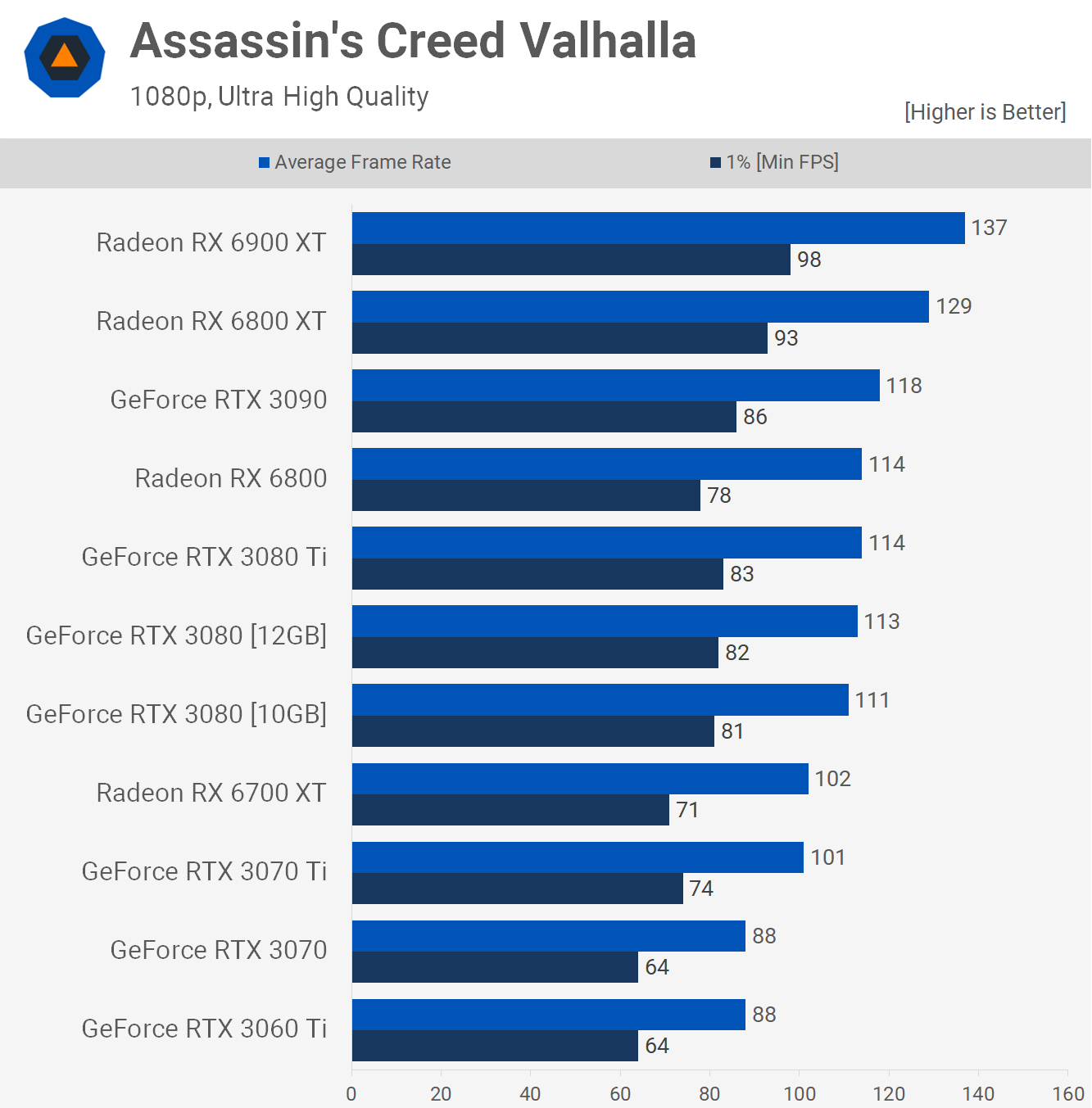
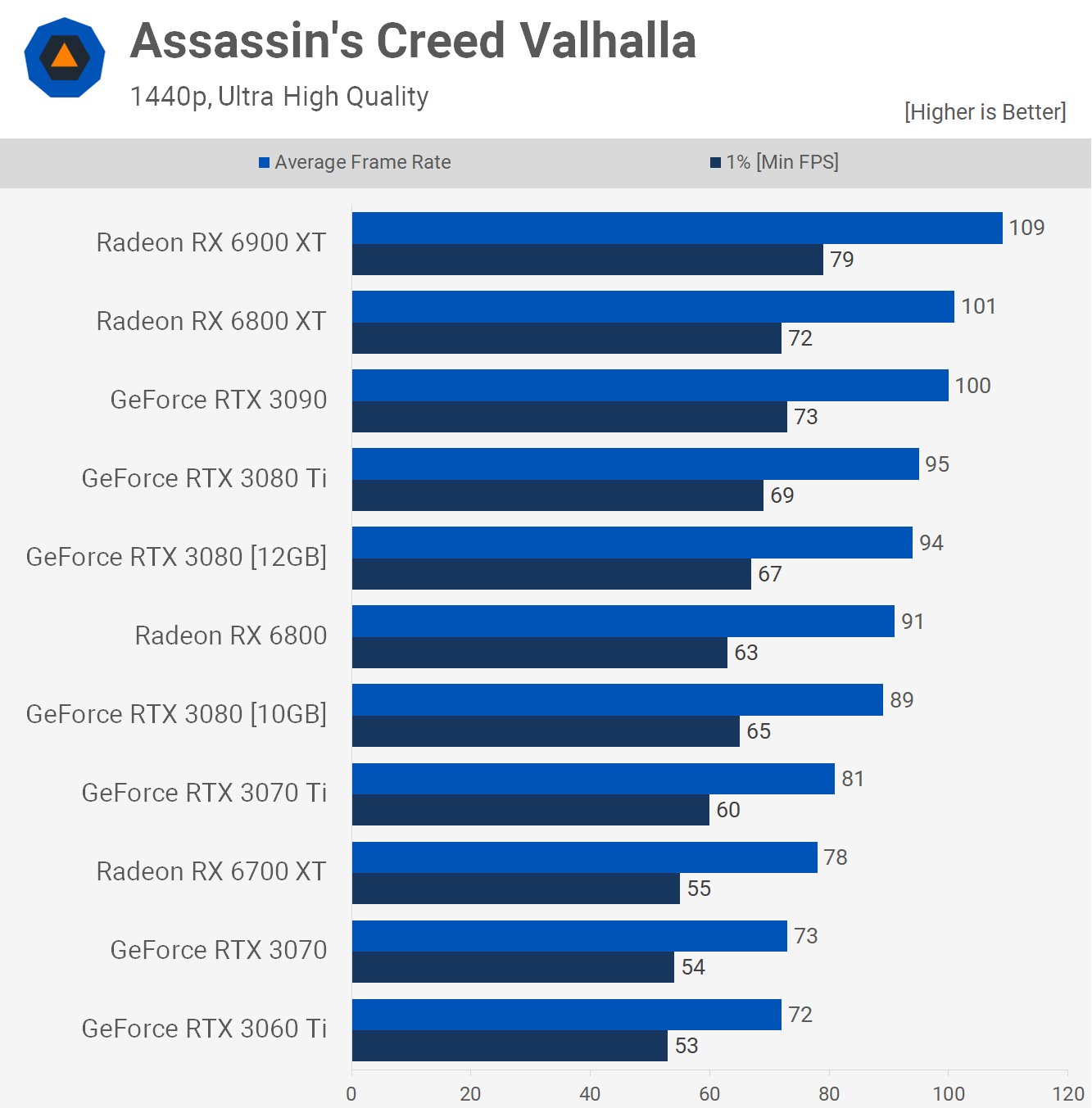
That margin is halved at 1440p with the 6800 XT now just 7% faster than the 12GB 3080, while the updated GeForce GPU basically matched the 3080 Ti, while offering an extremely mild 6% gain over the original 10GB 3080.
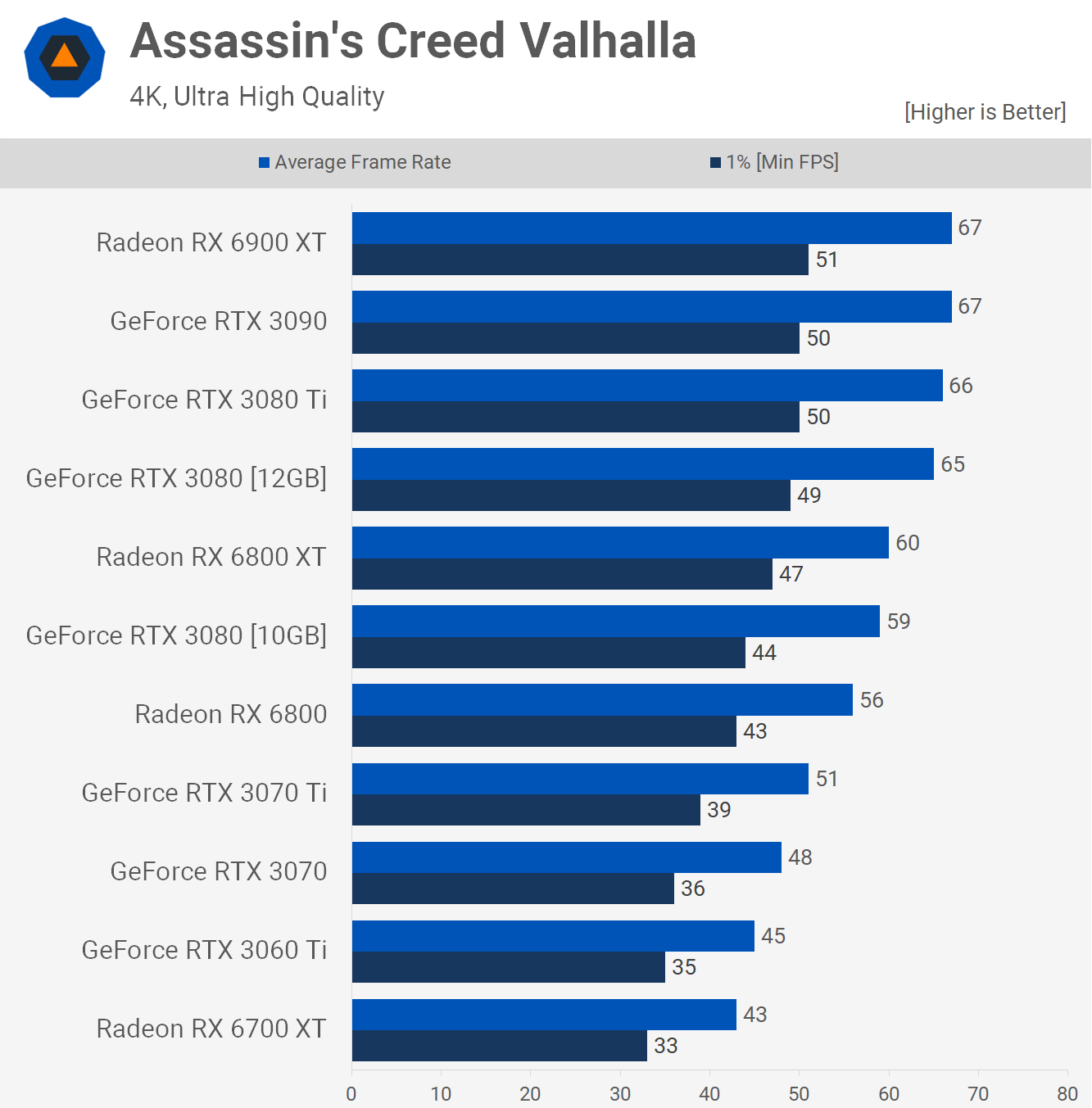
Then at 4K the new 12GB 3080 overtakes the 6800 XT, beating it by 8%, while surpassing the original 3080 by 10%. It was also within a frame of the 3080 Ti, so we're looking at 3080 Ti-like performance in this title.
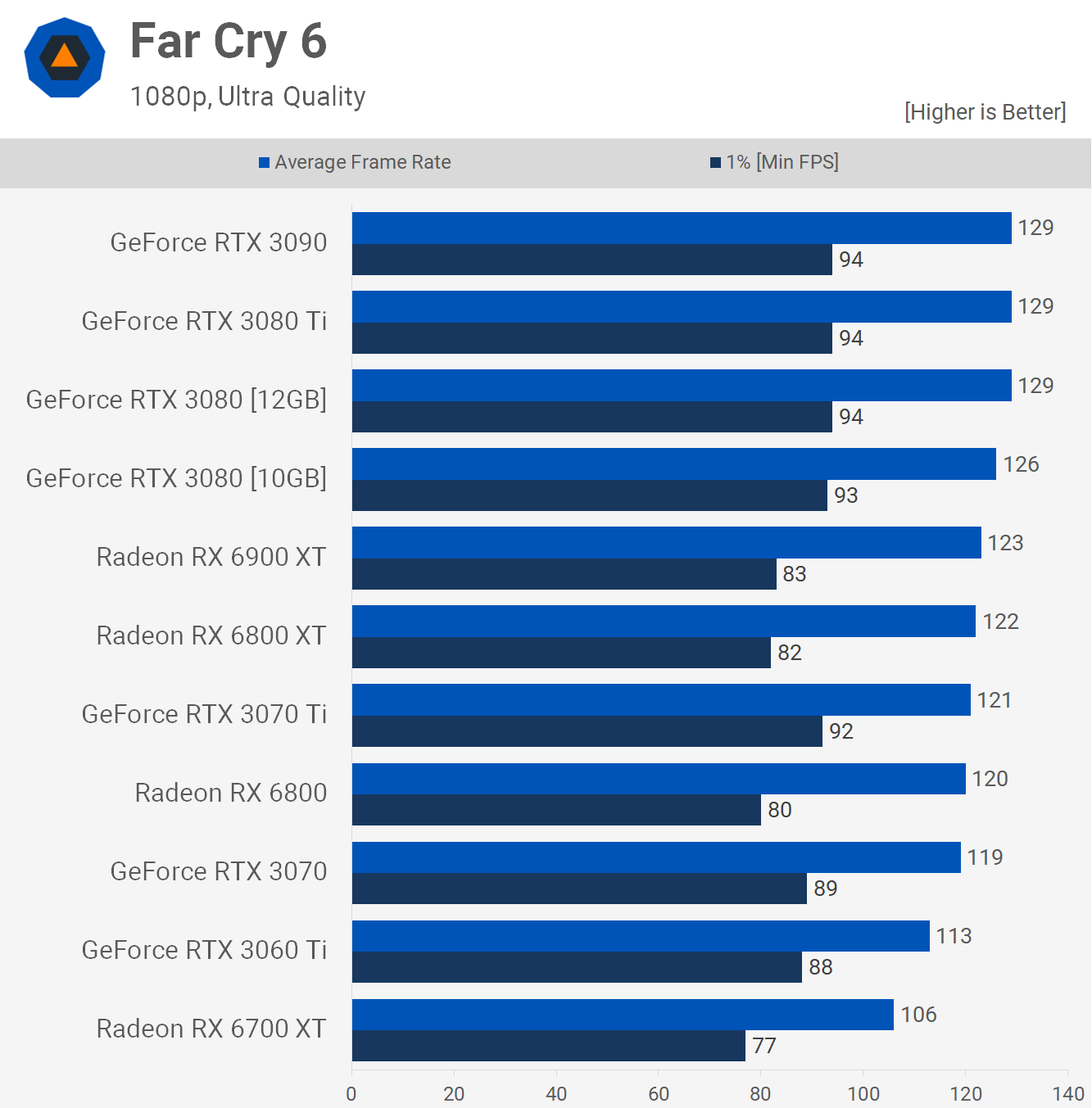
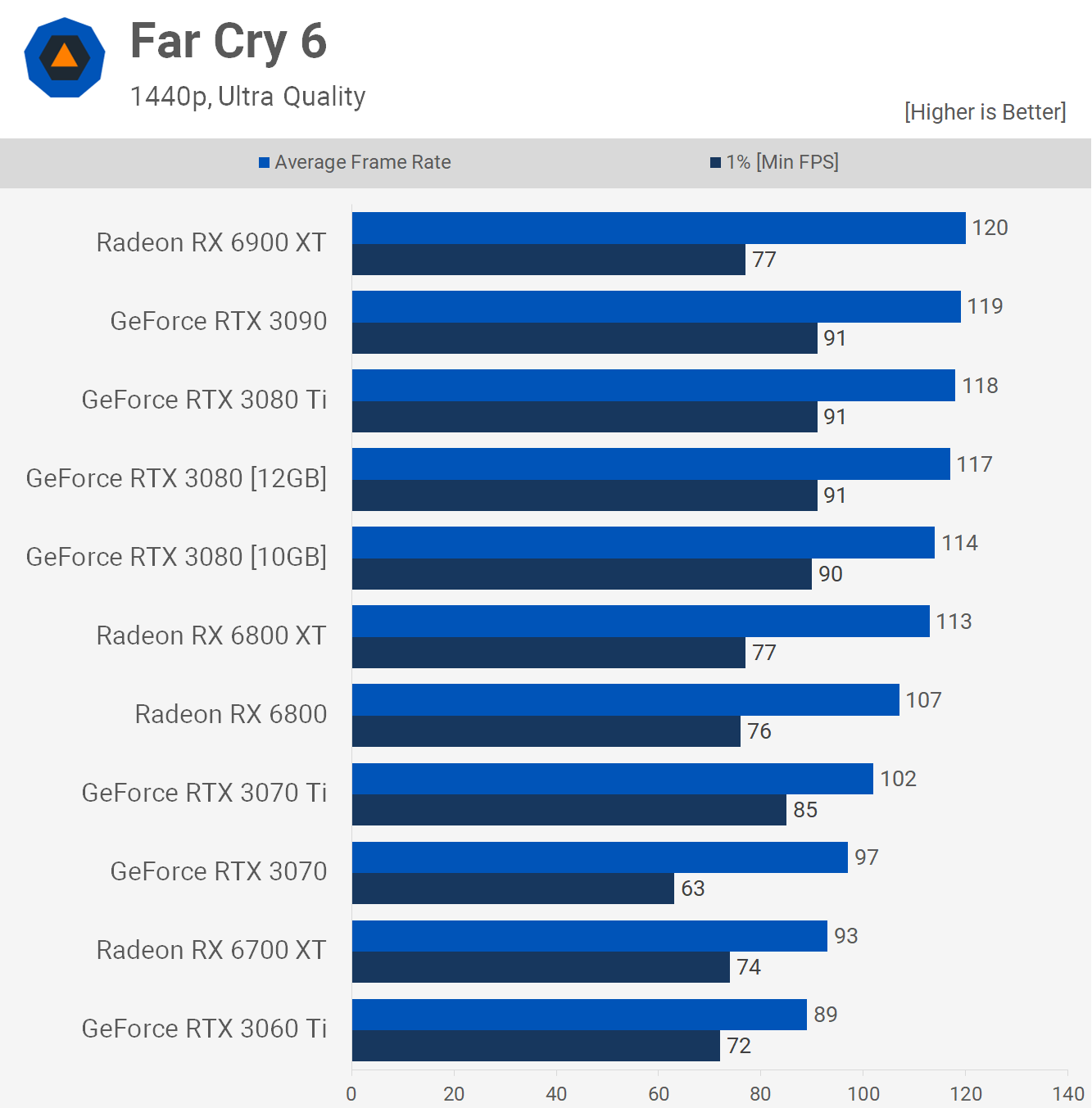
Next, we have Far Cry 6, and here we're CPU limited at 1080p and that means no difference in performance between the 3080 variants, along with the 3080 Ti and 3090. It's actually a similar story at 1440p with these high-end GPUs and although the 6900 XT hits the lead, it's well down when it comes to 1% low performance.
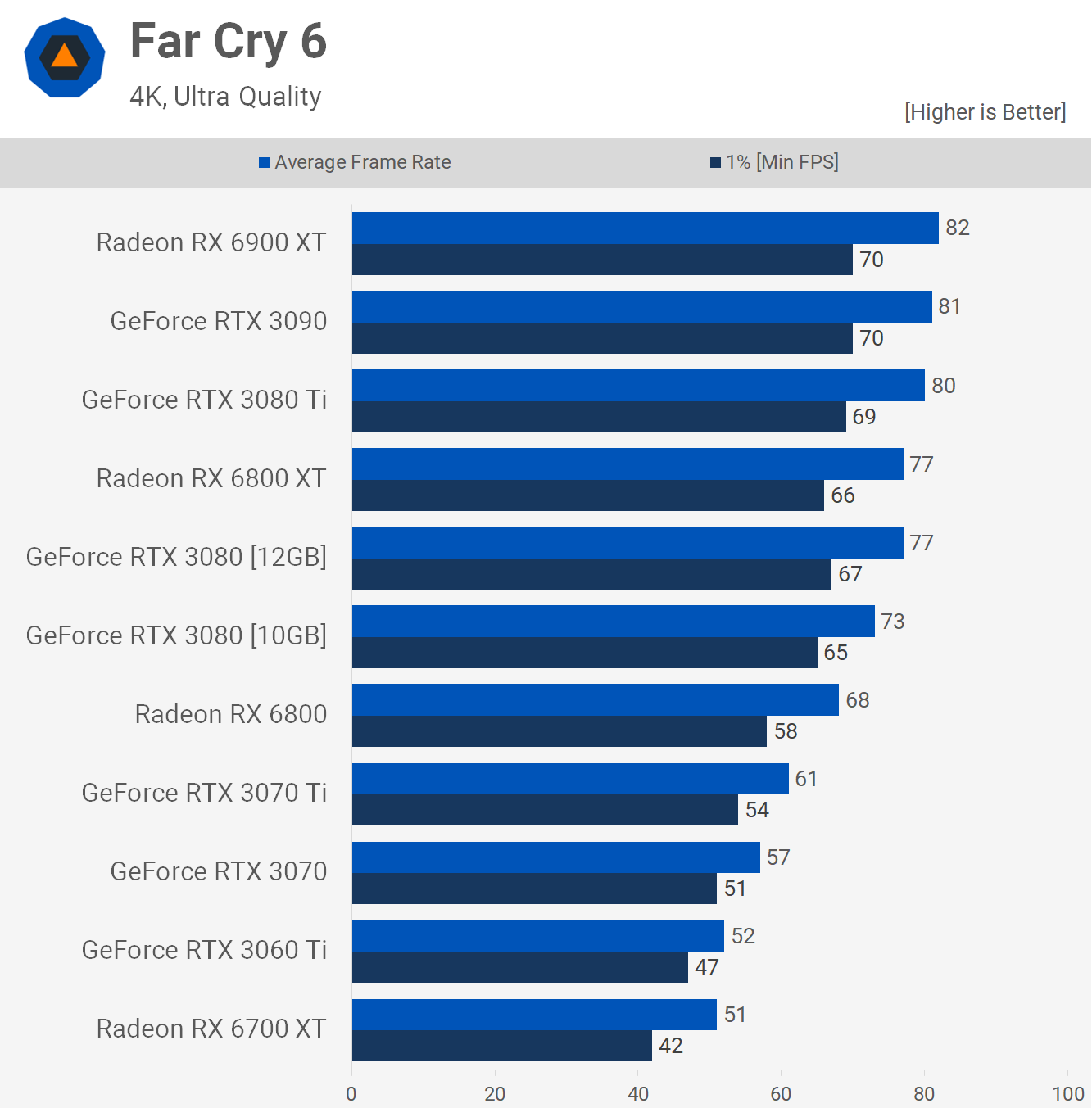
At 4K, those weaker 1% lows of the Radeon GPUs are gone, likely because frame rates aren't driving quite as high, and we're now seeing the 12GB 3080 matching the 6800 XT with 77 fps on average, placing it pretty well between the 10GB version and 3080 Ti.
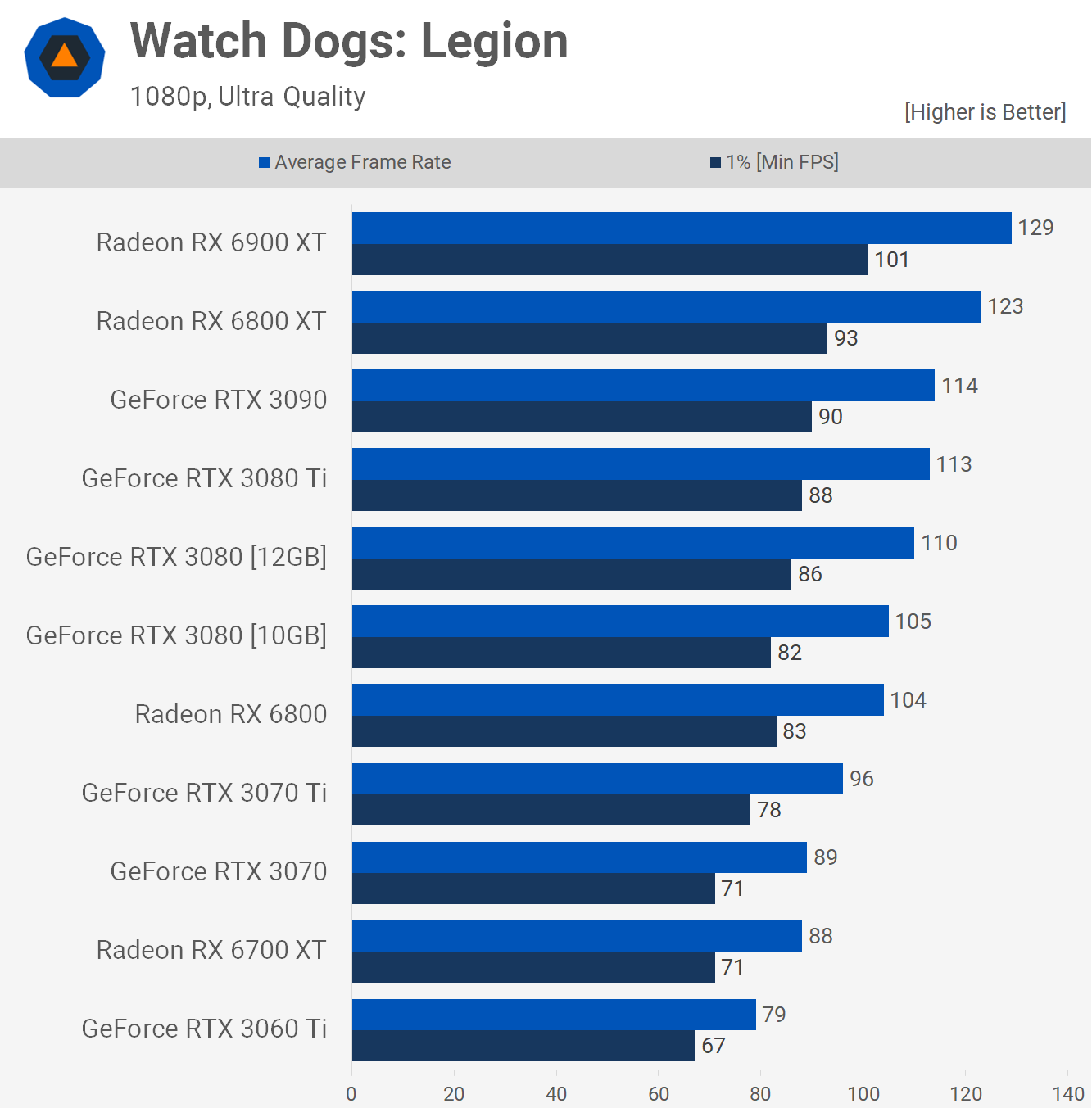
Watch Dogs Legion presents us with more of the same, at 1080p the Radeon GPUs generally perform better, while the 12GB 3080 can be found between the 10GB 3080 and 3800 Ti, but generally closer to the Ti model.
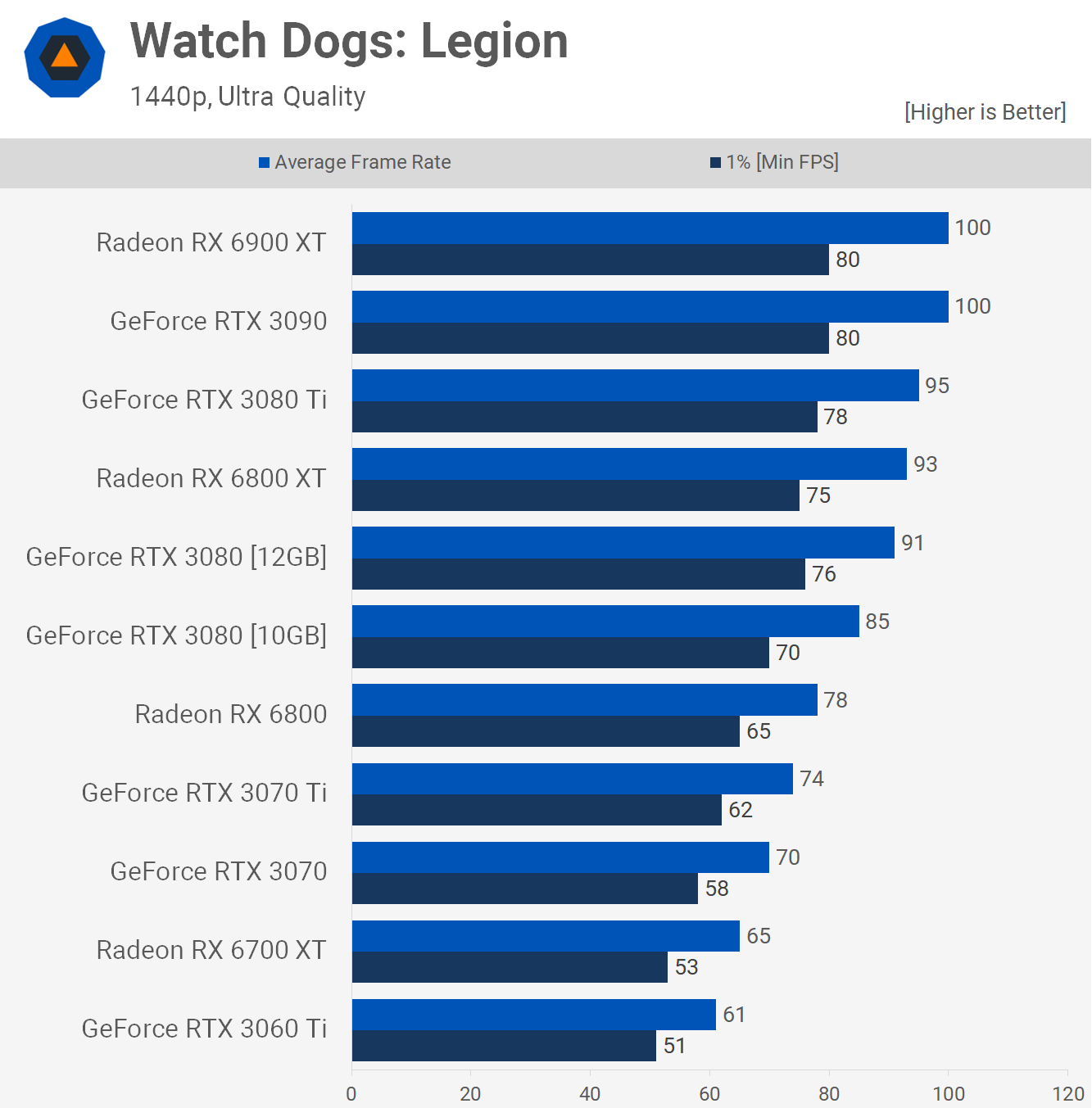
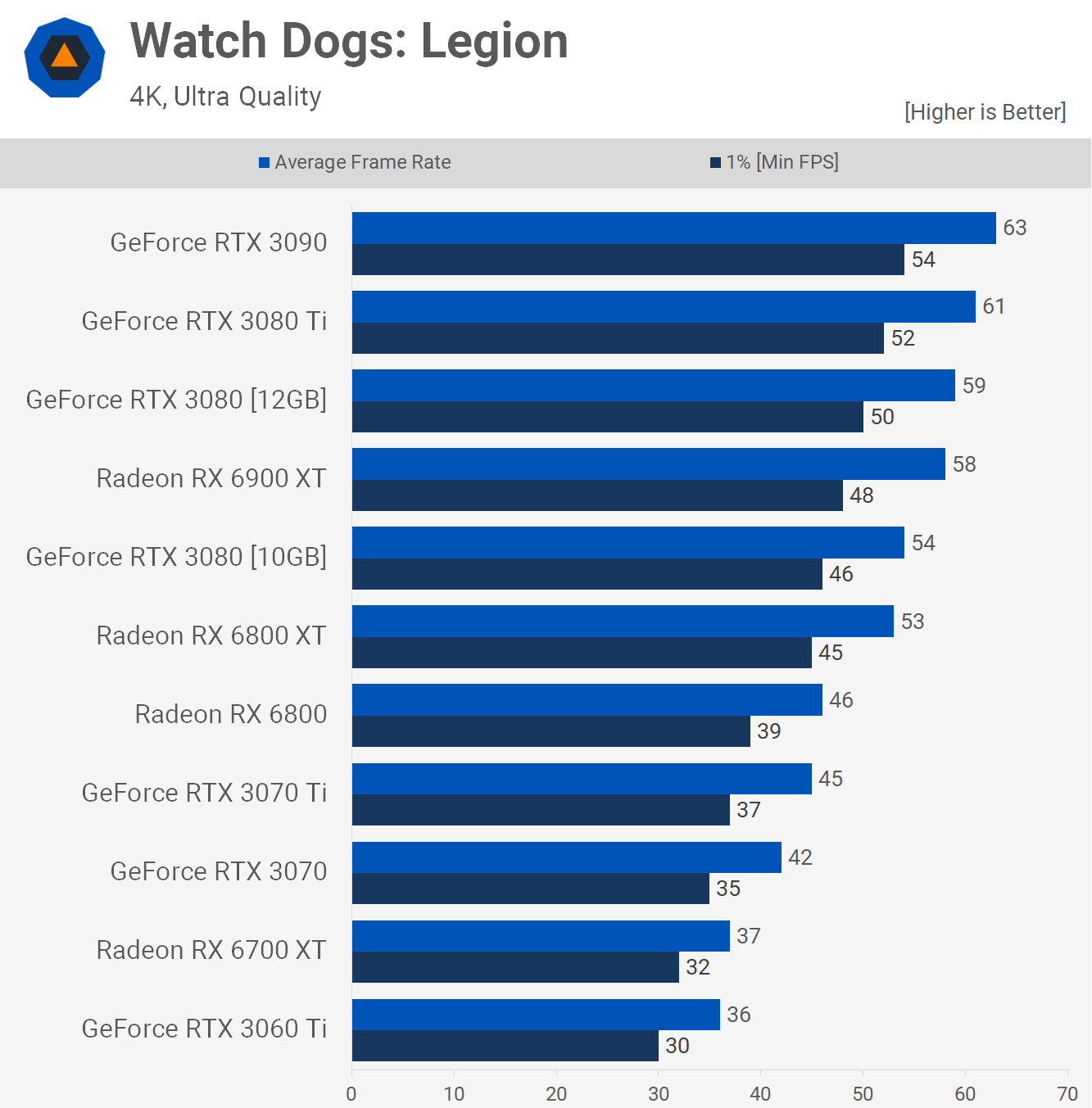
Moving up to 1440p sees the 12GB model outpace the 10GB version by a 7% margin, making it just 4% slower than the 3080 Ti, and roughly on par with the 6800 XT. Then as expected, the Ampere GPUs fares best at 4K. Here the 12GB 3080 was 11% faster than the 6800 XT, which is a commanding lead, and just 3% behind what was achieved by the 3080 Ti.
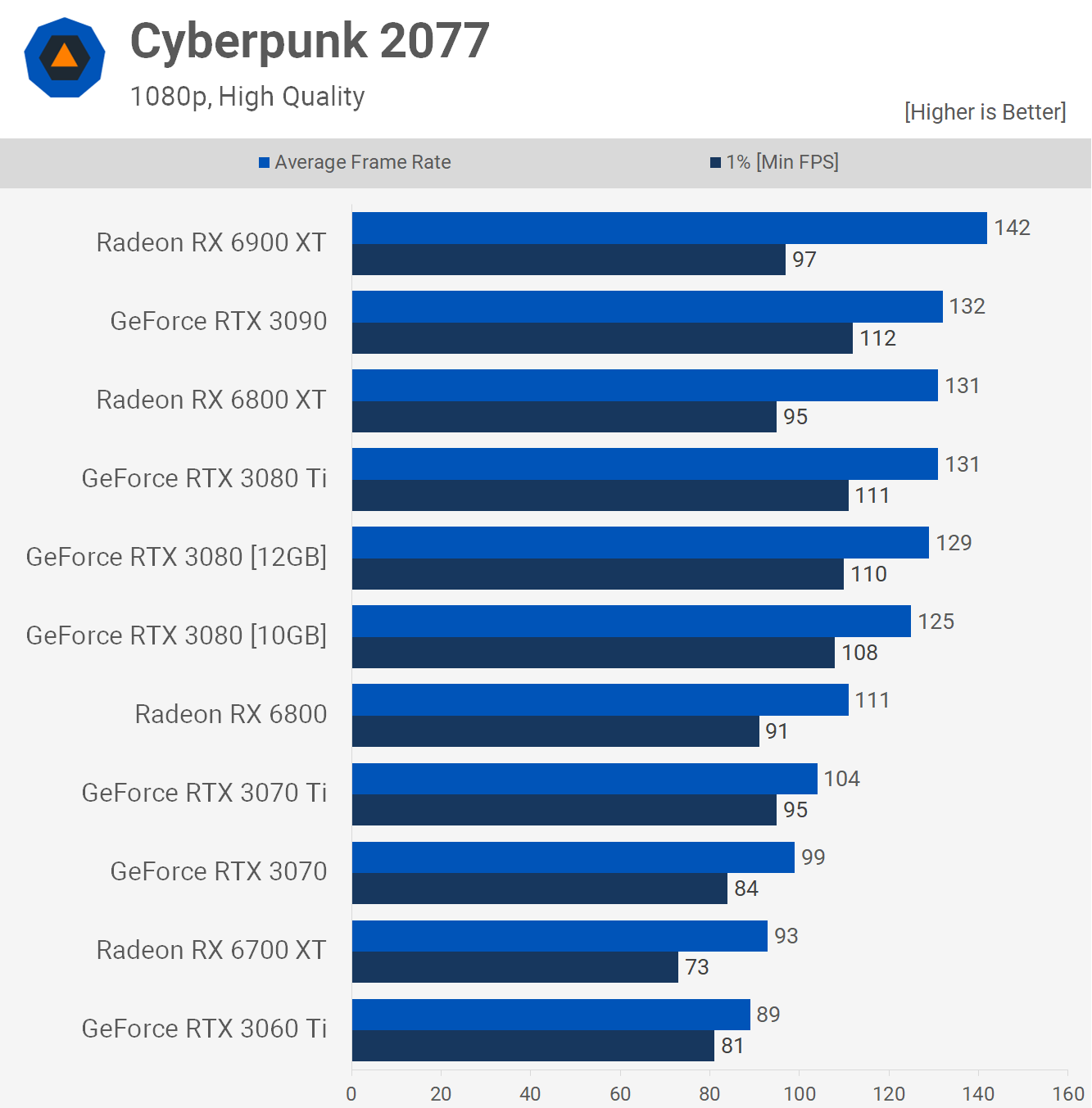
Last up we're going to look at Cyberpunk 2077. We've tested more games but for this review we'll skip all that repetitive data and jump to the 12-game average. The 1080p data is as expected, the 12GB 3080 basically matched the 3080 Ti making it a fraction faster than the original 3080.
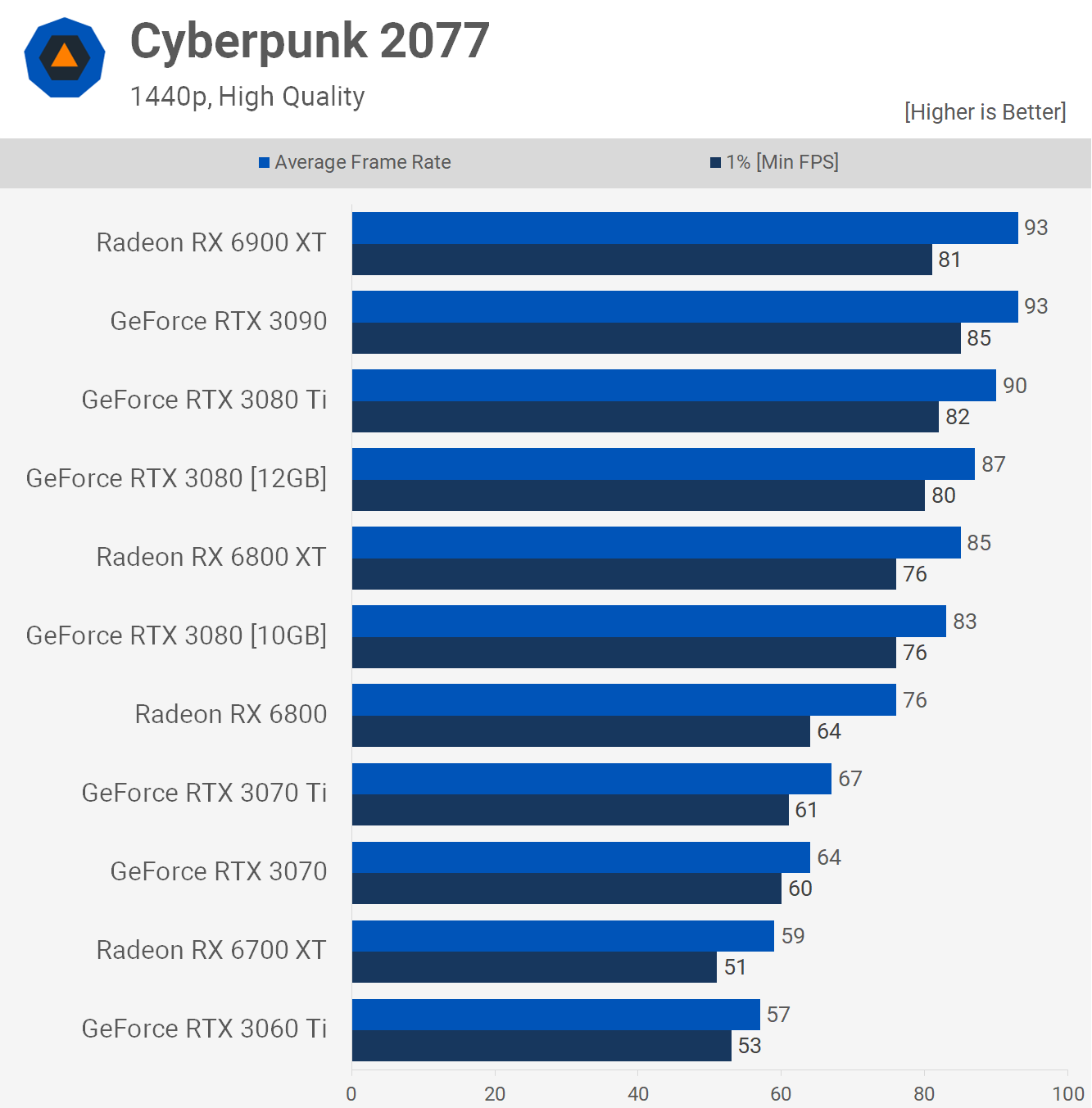
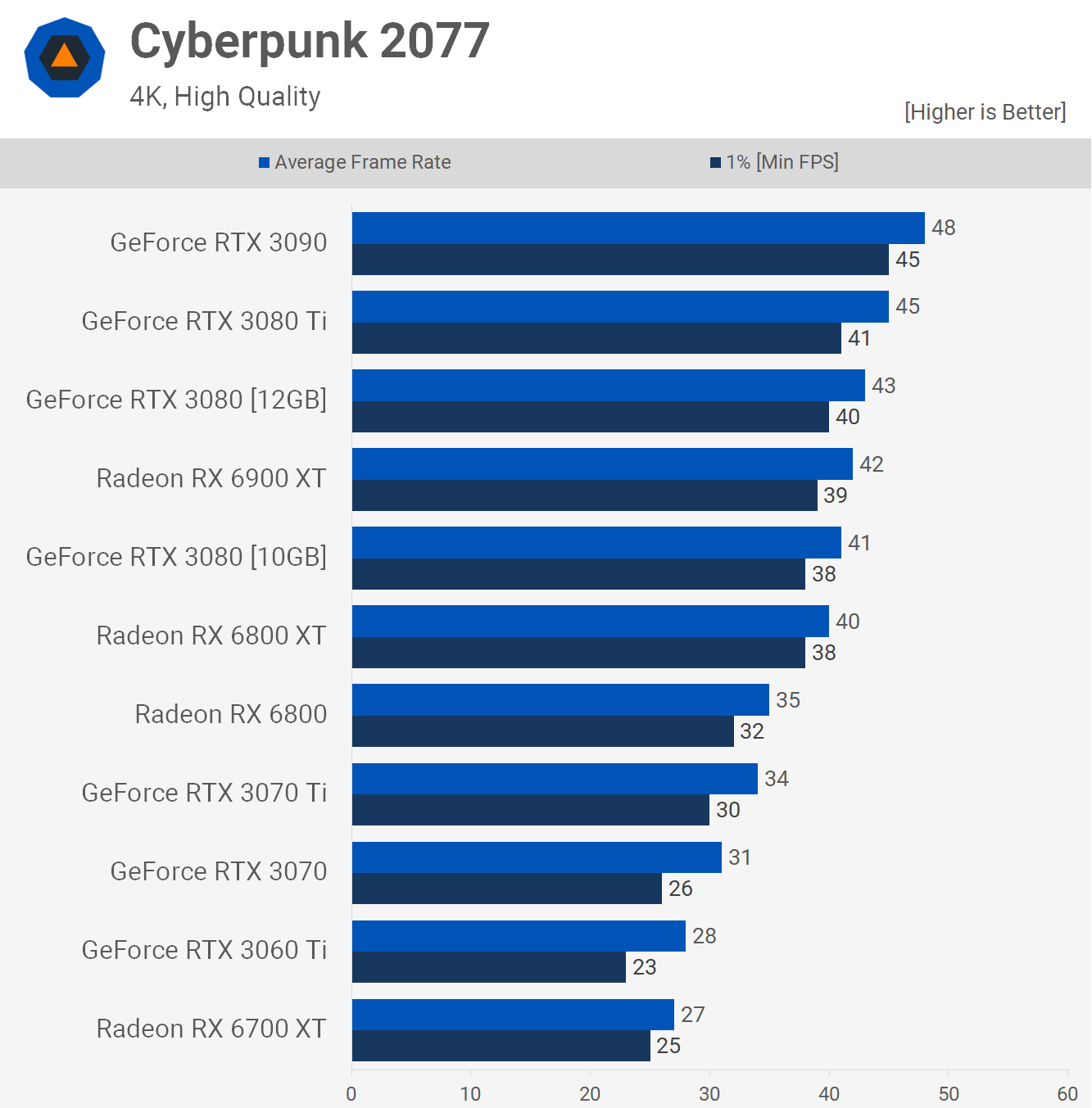
At 1440p the margins open up a little, the 3080 12GB is now 5% faster than the 10GB version and just 3% slower than the 3080 Ti. Technically, the 3080 is now faster than the 6800 XT, though the margin is ultimately worthless. Then at 4K, the 12GB 3080 nudged ahead of the 6900 XT to beat the 6800 XT by an 8% margin, making it just 4% slower than the 3080 Ti, so that's probably enough looking at individual game data.
Performance Comparisons
Here's the 12 game average data at 1080p, and as you can see the small upgrade has allowed the 12GB 3080 to match the 6800 XT, but all it needed was a 4% boost. If the original 3080 and 3080 Ti weren't close enough for you, the 12GB model is just 1.5% slower. That's some heavy product segmentation, but then we are only at 1080p.

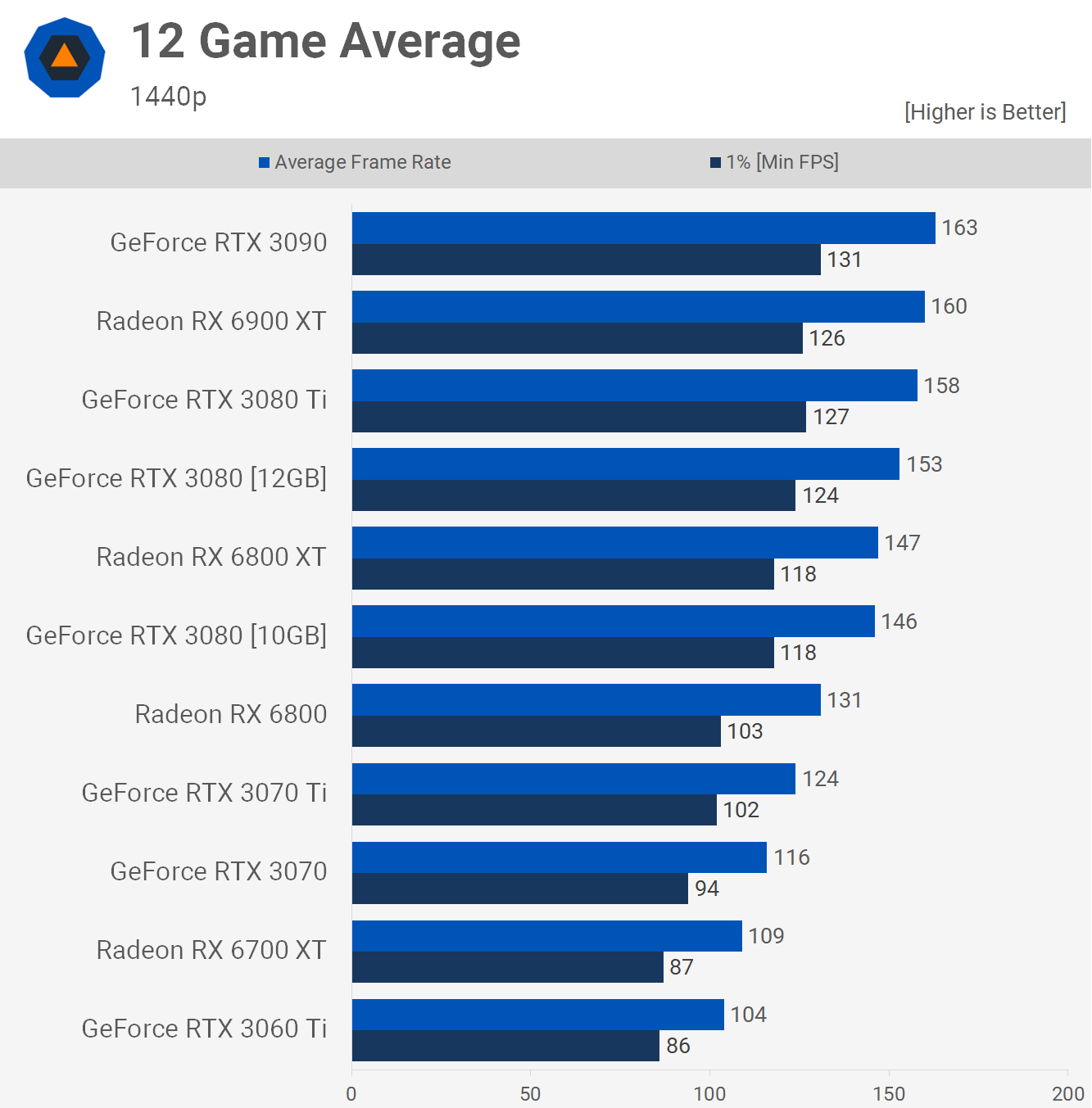
Jumping up to 1440p we see that the original 3080 and 6800 XT are evenly matched, so the mere 5% boost offered by the 12GB model is enough to hit the lead by a minor margin, and now it's just 3% slower than the 3080 Ti.
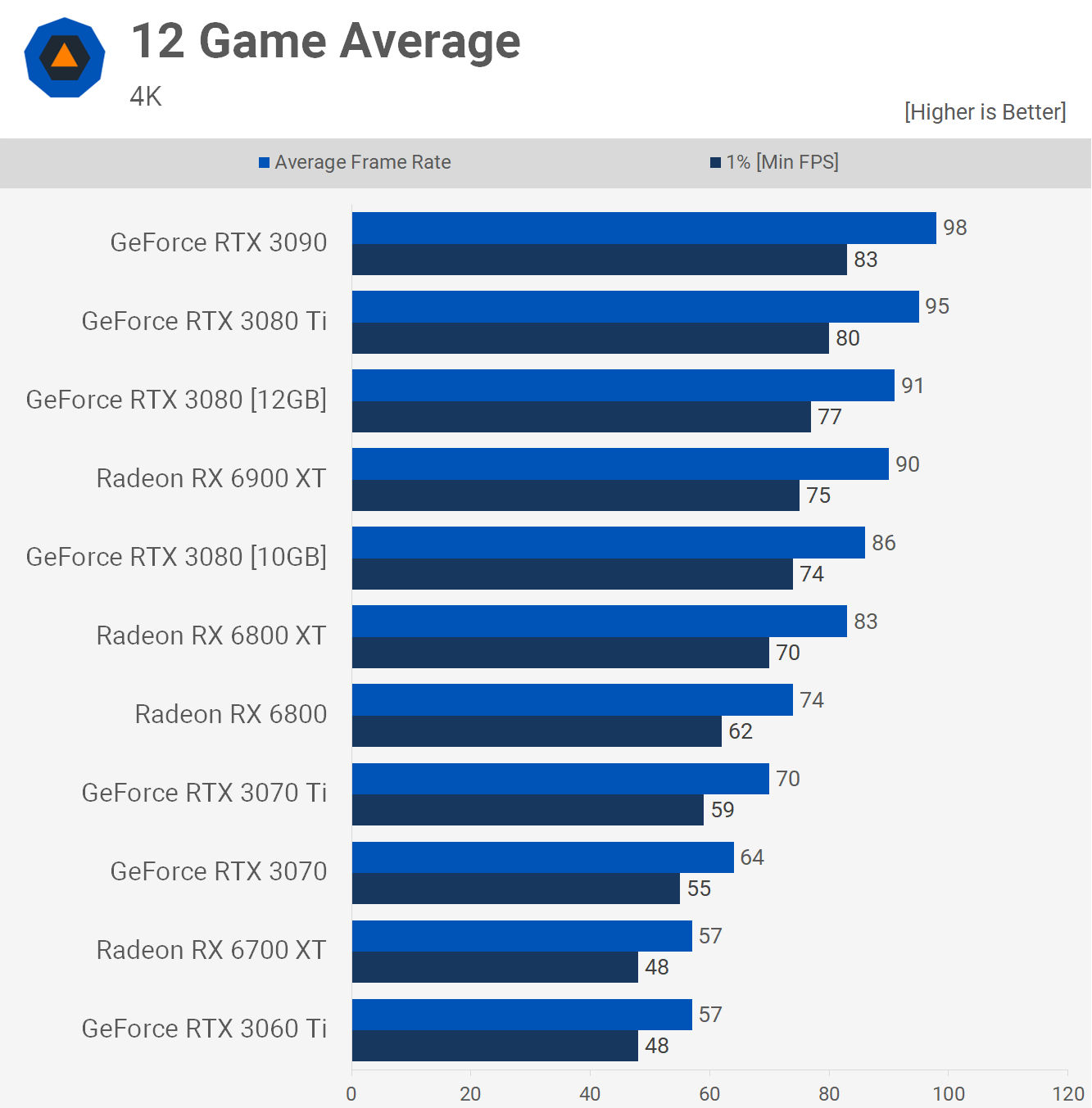
When compared to its Radeon competition, Nvidia's Ampere is at its best when playing games at 4K and here the 12GB 3080 was 10% faster than the 6800 XT, which is a reasonable margin. That's a 6% improvement over the original 3080 and 4% slower than the 3080 Ti.
Power Consumption
Take the 12GB 3080 numbers as a ballpark figure, that's because for most of these cards we've used the Nvidia Founders Edition models which are better power optimized when compared to MSI's beefy Suprim X version.

Even though the Suprim X is downclocked, the voltages aren't optimized for the default clock speeds, and this increases power usage. Had we received an FE model, we'd expect power consumption to land somewhere between the original 3080 and 3080 Ti.
Ray Tracing Performance
Before wrapping things up we'll take a quick look at ray tracing. Like the rasterization results, nothing will have changed from the original 3080 and 3080 Ti testing. For example, in Cyberpunk 2077 the 6800 XT is crippled with any form of ray tracing enabled, with the high setting hitting frame rates by 46%.
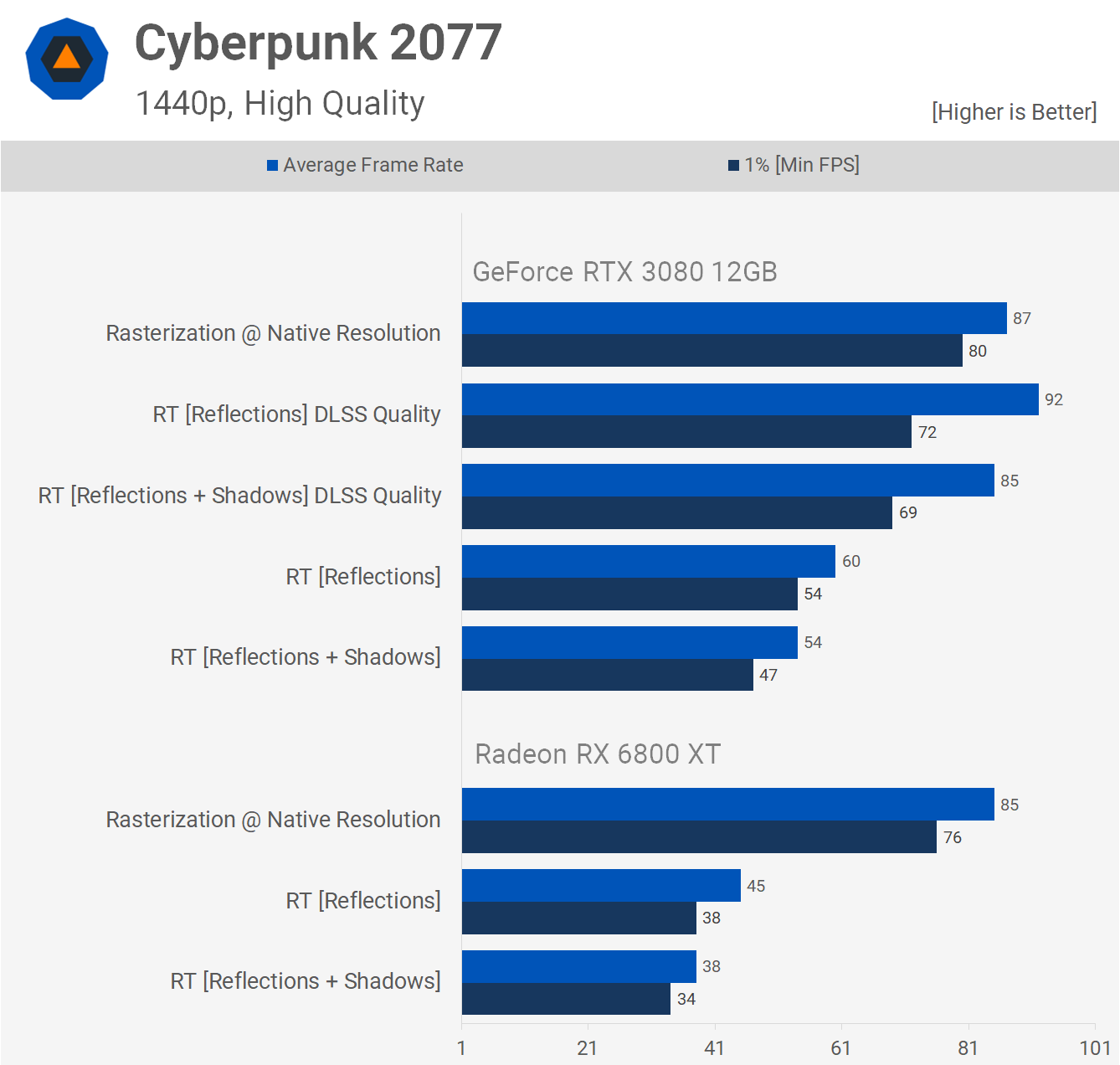
The 12GB 3080 is still hit hard, dropping 31% of its original performance, but enabling DLSS restores frame rates to roughly what we saw without RT enabled. Of course, image quality isn't quite as good as native, but the latest version of DLSS works very well in this game, so for the full effect ray tracing + DLSS is the way to go, but whatever your preference, there are more options available with the RTX 3080.
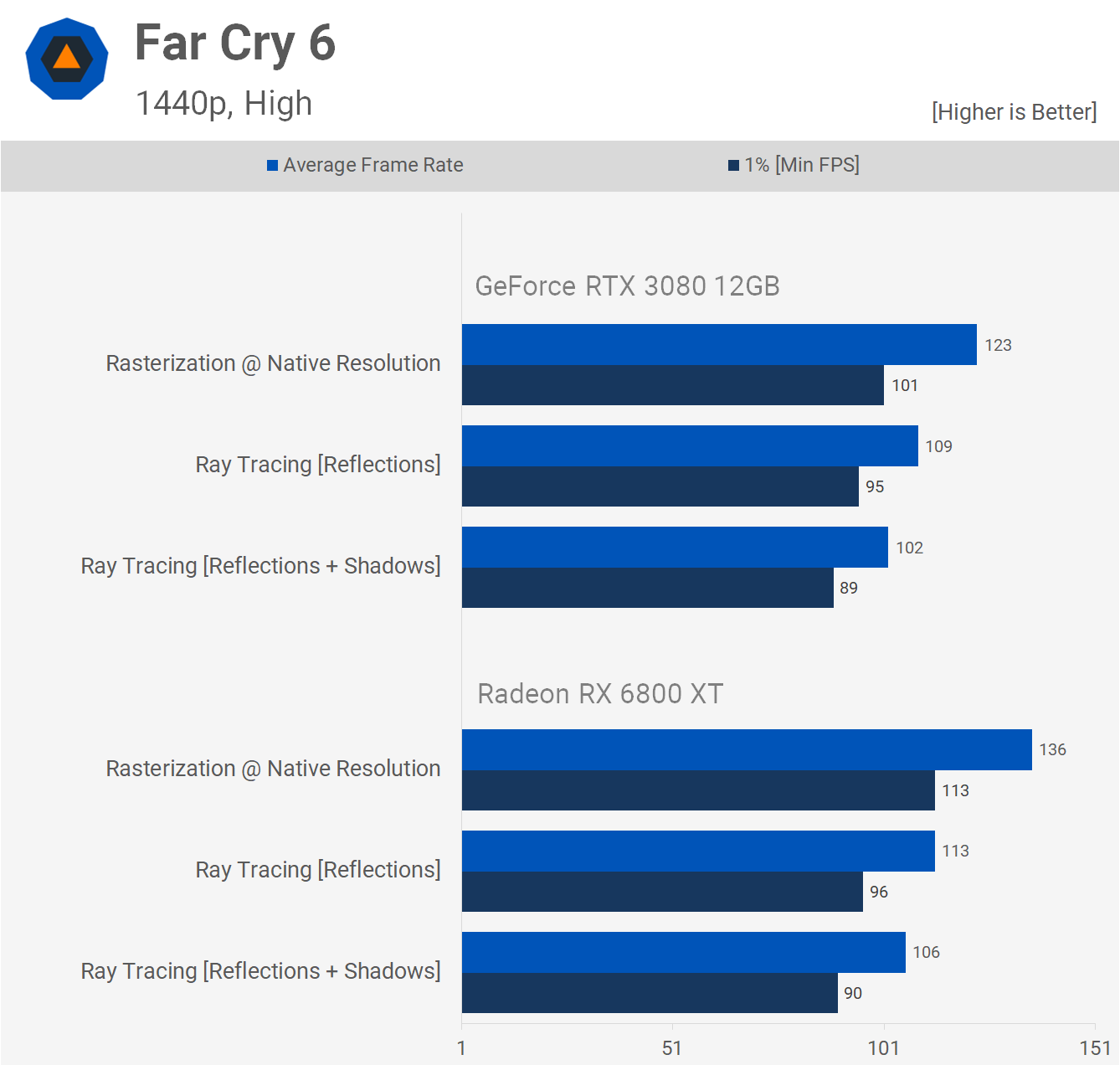
Ray tracing in Far Cry 6 is more subtle, though some areas of the game do look very impressive with it enabled. As an AMD sponsored title this one is better optimized for RDNA2 GPUs, so the 6800 XT is respectable here.
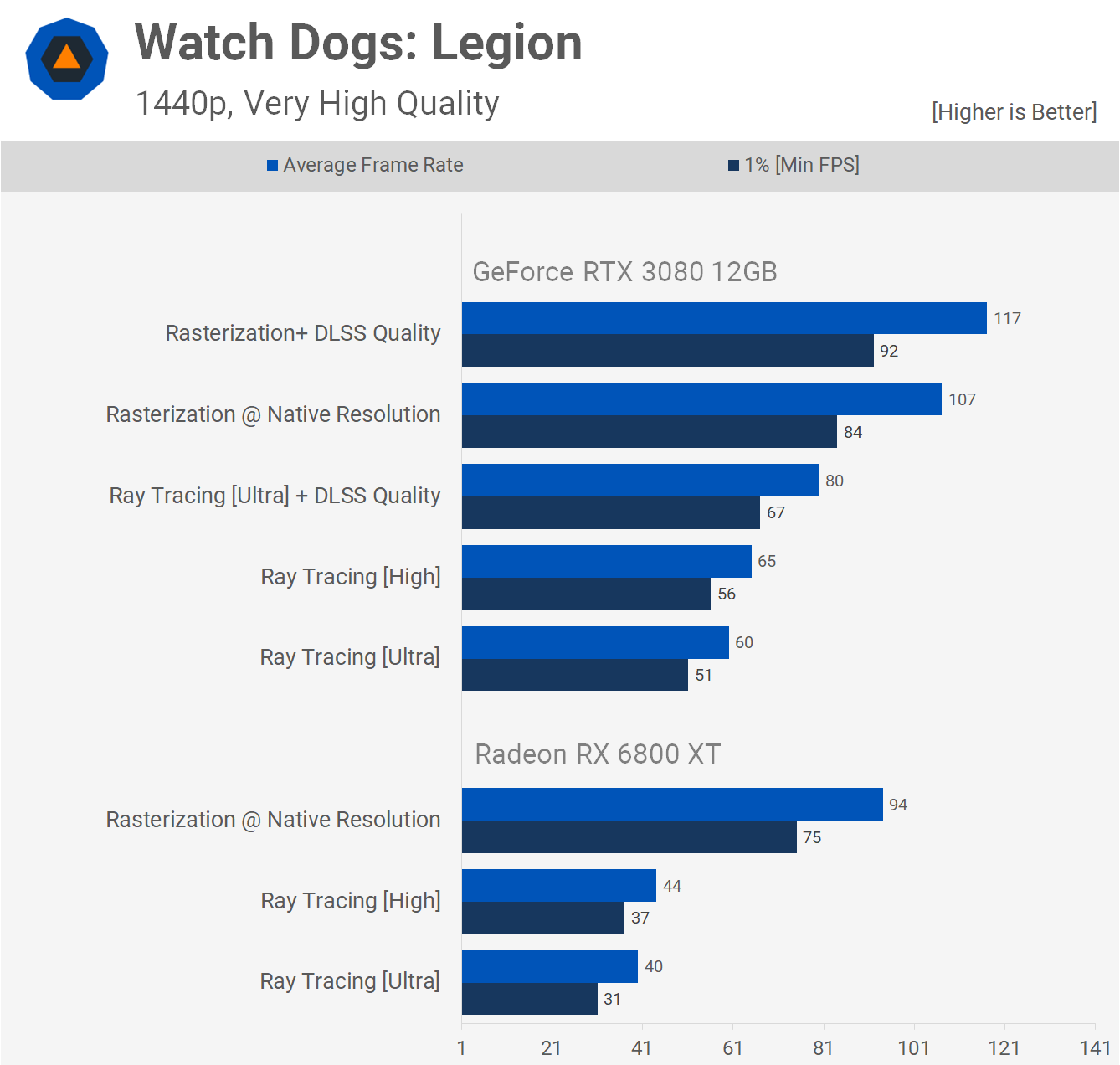
Watch Dogs Legion, on the other hand, is Nvidia sponsored. It was also released well before AMD's RDNA2 architecture, so very little optimization for Radeon GPUs has been done here. As a result, the 6800 XT takes a 53% performance hit with high quality RT enabled, while the 12GB 3080 takes a 39% hit, but with DLSS enabled can restore most of that performance, seen with the ultra settings which boosted performance by 33% with DLSS enabled. Alternatively, you can just enable DLSS without ray tracing and that resulted in a modest 9% gain.
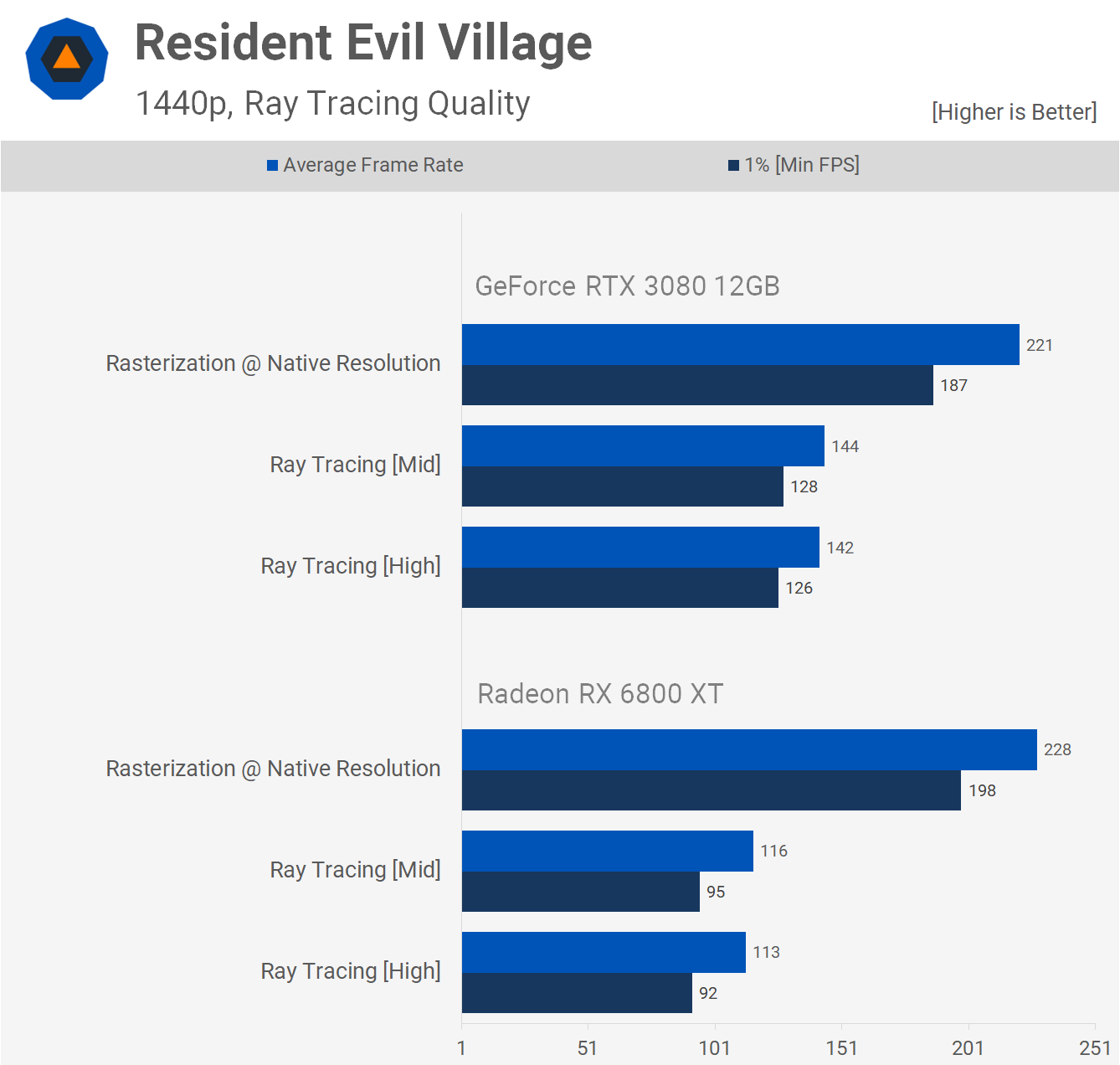
Resident Evil Village is an AMD sponsored game, so like Far Cry 6 we find that ray tracing isn't used quite as heavily, and it's used in a way that works better with AMD's implementation. Still, we're looking at a 49% hit for the 6800 XT with a 35% hit for the 12GB 3080, though in both cases performance at 1440p remains excellent.
Overclocking & Temps
Here's a quick look at how the MSI RTX 3080 12GB Suprim X performs out of the box. After 30 minutes of gameplay, the GPU temperature peaked at 77C which is quite high, though we're looking at a relatively low fan speed of 1500 RPM, meaning the card was basically whisper quiet. This is impressive given GPU power was up around 390 watts. The typical core clock speed was 1905 MHz, and of course, the memory operated at 19 Gbps.
Overclocked, our sample peaked at 78C, with a very slight increase in fan speed and here it averaged 1950 MHz, a mere 2% boost from stock. Going higher would cause the card to crash. The memory also peaked at 20 Gbps, which is an insignificant 5% bump. In other words, stock the Suprim X wasn't far from being maxed out.
Who Is It For?
That's how the GeForce RTX 3080 12GB performs, and as expected, there are no surprises. For Nvidia, the 12GB version of the RTX 3080 allows them to significantly boost profit margins on silicon that would have otherwise sold as the original 10 GB model, and therefore allows board partners and/or distributors to cash in on the current market's demand. Of course, we'd prefer if they looked after loyal customers who ordered an RTX 3080 at a reasonable price 16 months ago, but clearly there's no business incentive in doing that.
So, we know exactly why Nvidia has released the 12GB 3080, and why they're not crazy about reviewers getting their hands on them, but what does it mean for consumers? Frankly, not a lot. Those of you holding out for cheaper prices will have to continue to remain patient, and Nvidia's move to further segment the GA102 lineup does nothing to improve supply.
There's no good news here, unless you already planned to overpay for a graphics card. The 12GB 3080 is already on sale in a few countries, and when compared to the 3080 Ti, we guess you could say it's... "better" value.
The original RTX 3080 (10GB) is listed for as little as $1,400 in the US, but they're mostly out of stock at that price, while the 3080 Ti is closer to $2,000 and then new 12GB version is selling somewhere in the middle. Based on those street price points, the 10GB model still offers the best value for gamers, but the 12GB model is better than the 3080 Ti (woo!). Of course, you shouldn't buy any of them, but that's how the market is pricing these products.
That's all we have to say about the 12GB RTX 3080. On a final note, the MSI RTX 3080 12GB Suprim X is a beast of a graphics card, it's just a shame we can't recommend you buy one at this point.
